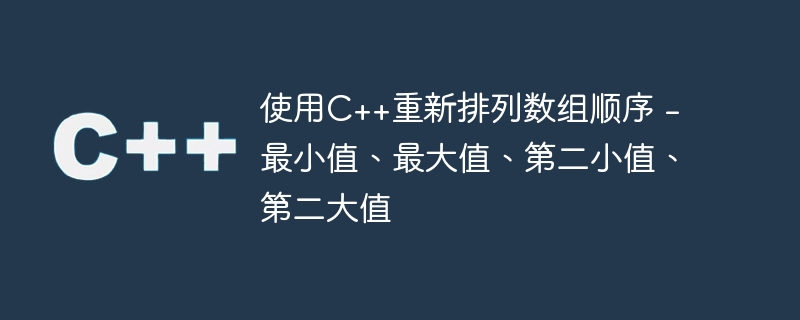
我们得到一个数组;我们需要按以下顺序排列此数组:第一个元素应该是最小元素,第二个元素应该是最大元素,第三个元素应该是第二个最小元素,第四个元素应该是第二个最大元素,依此类推示例 -
'Input : arr[ ] = { 13, 34, 30, 56, 78, 3 }
Output : { 3, 78, 13, 56, 34, 30 }
Explanation : array is rearranged in the order { 1st min, 1st max, 2nd min, 2nd max, 3rd min, 3rd max }
Input : arr [ ] = { 2, 4, 6, 8, 11, 13, 15 }
Output : { 2, 15, 4, 13, 6, 11, 8 }寻找解决方案的方法
可以使用两个变量“x”和“y”来解决它们所指向的位置到最大和最小元素,但是对于该数组应该是排序的,所以我们需要先对数组进行排序,然后创建一个相同大小的新空数组来存储重新排序的数组。现在迭代数组,如果迭代元素位于偶数索引,则将 arr[ x ] 元素添加到空数组并将 x 加 1。如果该元素位于奇数索引,则将 arr[ y ] 元素添加到空数组空数组并将 y 减 1。执行此操作,直到 y 变得小于 x。
示例
'#include <bits/stdc++.h>
using namespace std;
int main () {
int arr[] = { 2, 4, 6, 8, 11, 13, 15 };
int n = sizeof (arr) / sizeof (arr[0]);
// creating a new array to store the rearranged array.
int reordered_array[n];
// sorting the original array
sort(arr, arr + n);
// pointing variables to minimum and maximum element index.
int x = 0, y = n - 1;
int i = 0;
// iterating over the array until max is less than or equals to max.
while (x <= y) {
// if i is even then store max index element
if (i % 2 == 0) {
reordered_array[i] = arr[x];
x++;
}
// store min index element
else {
reordered_array[i] = arr[y];
y--;
}
i++;
}
// printing the reordered array.
for (int i = 0; i < n; i++)
cout << reordered_array[i] << " ";
// or we can update the original array
// for (int i = 0; i < n; i++)
// arr[i] = reordered_array[i];
return 0;
}输出
'2 15 4 13 6 11 8上述代码说明
- 变量初始化为x=0 和 y = array_length(n) - 1。
- while( x<=y) 遍历数组,直到 x 大于 y。
- 如果计数为偶数 (x),则将该元素添加到最终数组,并且变量 x 递增1。
- 如果 i 是奇数,则将 (y) 该元素添加到最终数组中,并且变量 y 减 1。
- 最后,存储重新排序后的数组在reordered_array[]中。
结论
在本文中,我们讨论了以最小、最大形式重新排列给定数组的解决方案。我们还为此编写了一个 C++ 程序。同样,我们可以用任何其他语言(如 C、Java、Python 等)编写此程序。我们希望本文对您有所帮助。



